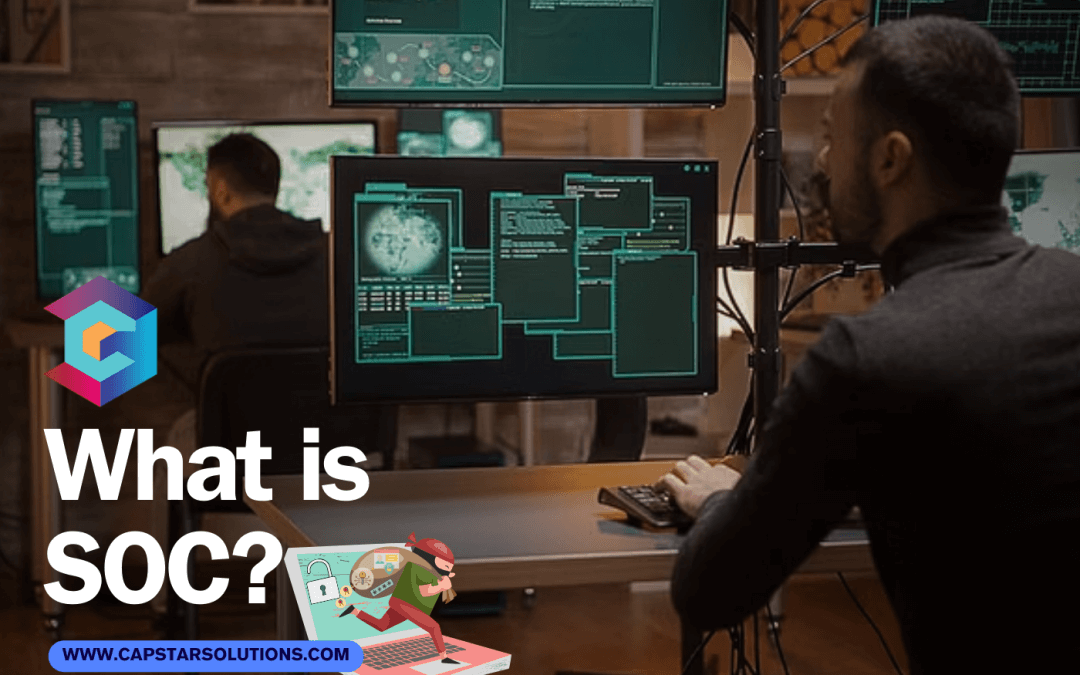
What is SOC? Understanding Its Role in Security
Do you know What is a SOC (security operations center)? Here, we are going to explain the roles and responsibilities in security. The function of the security operations center (SOC) is to monitor, prevent, detect, investigate, and respond to cyber threats around the clock. A SOC acts like the hub or central command at that post, taking in telemetry from across an organization’s IT infrastructure, which includes its networks, devices, appliances, and information stores, wherever those assets reside. The proliferation of advanced threats places a premium on collecting context from diverse sources.
What does SOC mean?
SOCs are an integral part of minimizing the costs of a potential data breach, as they not only help the organizations that respond to intrusions quickly but also constantly improve the detection and prevention service processes.
Different Roles of SOC
Maintaining security monitoring tools
To effectively secure and monitor a system, there are many tools that the team must maintain and update regularly. Without a proper tool, it is impossible to effectively secure the systems and networks as well.
Security analyst
The security analysts are typically the first responders to the incidents. They are the soldiers on the front lines who are fighting against cyberattacks and analyzing the threats.
Security Engineer
The security engineers are responsible for maintaining the tools, recommending new tools, and updating the systems. Many security engineers specialize in SIEM platforms. The security engineers are responsible for building the security architecture and the systems. It also has a SOC report.
Security Manager
A security manager within a SOC team is responsible for overseeing the operations as a whole. They are in charge of managing team members and coordinating with the security engineers.
Chief Information Officer
The chief information security officer (CISO) is responsible for defining and outlining the organization’s security operations. They are the final word on the strategies, policies, and procedures involved in all aspects of cyber security within the organization.
Principles of SOC
The main principles of SOC are:
Security
- It is the most critical and, therefore, mandatory part of the criteria for every audit and is referred to as the common SOC 2 trust service criteria. It includes the security of information during its entire life cycle, from creation, use, processing, and transmission to storage.
Some examples of security controls are
- Access Controls
- Intrusion Detection Systems
- Anti-virus/malware
- Firewalls
Privacy
This TSC checks if you protect Personally Identifiable Information (PII) from breaches and unauthorized access. It does so by implementing rigorous access controls, two-factor authentication, and encryption.
Availability
To make sure that your systems adhere to operational uptime and performance standards, the controls in the availability criterion are literally concentrated on these two areas. Network performance monitoring and disaster recovery procedures are among the controls included here.
Confidentiality
Confidentiality helps showcase how you can safeguard confidential information throughout its lifecycle and the processes that are available in the data. The TSC encourages organizations to protect confidential information such as intellectual property, financial data, and other business-sensitive details specific to their contractual commitments with their customers.
Processing integrity
This principle is evaluated to determine if your cloud data is processed accurately, reliably, and on time. It also reviews if your systems can achieve their purposes.
Some examples of security controls are:
- Process Monitoring
- Quality Assurance
What are the five major steps for developing a SOC?
The five major steps that are involved in developing a SOC are:
Planning the SOC
- SOC mission statement
- SOC strategic goals
- SOC scope
- SOC model of operation
- SOC services
- SOC capabilities
- SOC key performance indicators
Designing and Building the SOC:
- a content filter that is aware of malicious web sources.
- IPS to detect attacks
- The Breach – detection technology looking for unknown threats missed by the IPS.
- A tool that baselines the network and then monitors it for unusual data trends.
Operating the SOC
- First, it is important to validate that the SOC still has executive sponsorship. In many cases, there is a large gap of time between the initial sign-off from the leadership to build a SOC and the point when the SOC is actually ready to operate.
- The processes will be challenging since some will be new and need to be tested.
- The technology needs to be checked to ensure that everything is functioning properly.
- The training may be needed for team members who are responsible for using and maintaining the solutions.
Reviewing the SOC: Determine the review’s scope
- This can include all the aspects of the SOC as part of a comprehensive review, but it is often more helpful to limit the scopes that focus on particular areas.
Determine the participants
You need to understand who will perform and participate in the review. The specific participants may depend on the scope of the review.
Establish a clear methodology
- You may need a clear methodology to guide any review, along with some expected and integrated outcomes and deliverables that are based on pre-determined templates.
Determine the frequency
- It decided how frequently to perform such reviews. Certain types of reviews may or should occur more and more often. For example, performing frequent post-incident reviews within the first 72 hours of an incident is recommended so that the individuals involved don’t forget the specific events associated with the incident.
Prioritize results and action items
- Any of the areas for improvement are related to the action items that need to be prioritized, executed, and followed up to ensure that necessary changes are completed.
FAQ (Frequently Asked Questions)
Which trust principle is not covered under SOC2?
According to SOC2, all five trust principles, i.e., security, availability, confidentiality, processing integrity, and privacy, are covered. Hence, there is no trust in the principle that is not covered under SOC2.
What are SOC2 Type 2 trust criteria?
The SOC2 Type 2 criteria are security, availability, confidentiality, processing integrity, and privacy. These criteria are often defined by the AICPA for evaluating an organization’s security for compliance with SOC2.
What is SOC?
The Security Operation Center (SOC) is a centralized function within an organization that employs people, processes, and technology to continuously monitor and improve an organization’s security postures while preventing, detecting, analyzing, and responding to cybersecurity incidents.
What are SOC reports?
A System and the Organizations Controls (SOC) The SOC report is a verifiable audit performed by a Certified Public Accountant (CPA) designated by the American Institute of Certified Public Accountants (AICPA).
Why is SOC used?
SOC gives the receiver of messages the ability to detect and replay recorded messages, check the authenticity of the sender, and evaluate the integrity of the transmitted data. For this purpose, the receivers checks what is known as the Messages Authentications Code (MAC), etc.
Where is SOC used?
This makes the SoC computers a very popular and amazing choice, and often the only choice, for use in their systems: the aircraft avionics systems, automobile communications, navigation, and entertainment panels. Automotive on-board diagnostics (OBD-II) scanners
What is an SOC analyst?
A SOC analyst is a cybersecurity specialist who actually monitors an organization’s IT infrastructure for threats. They are often the first responders in the battle against those threats.



